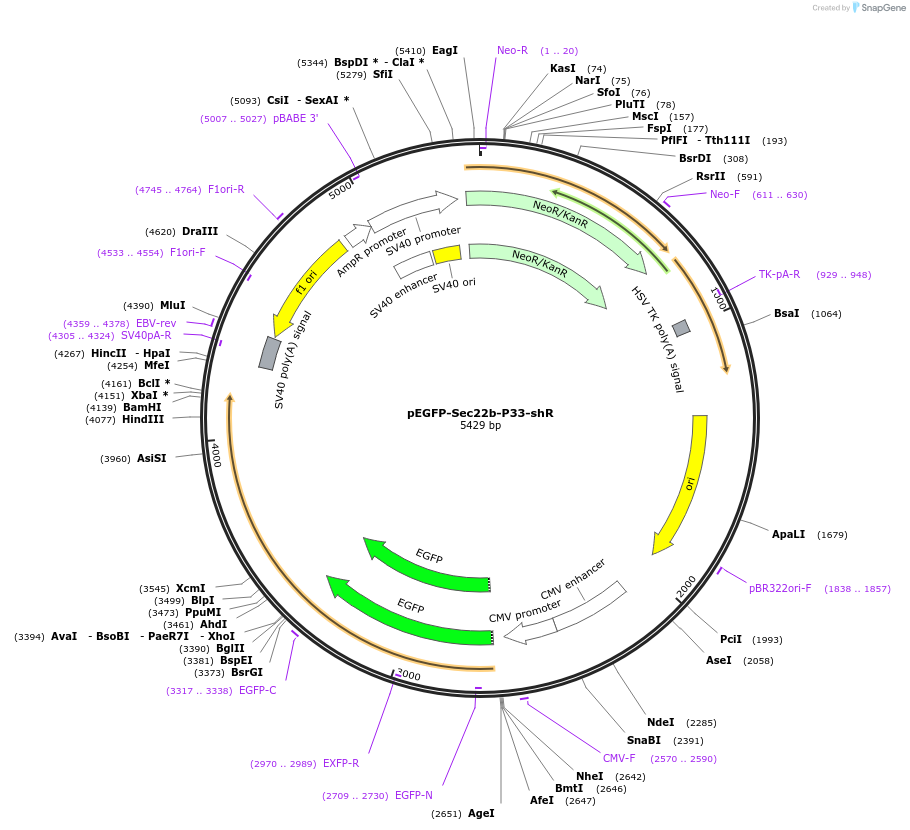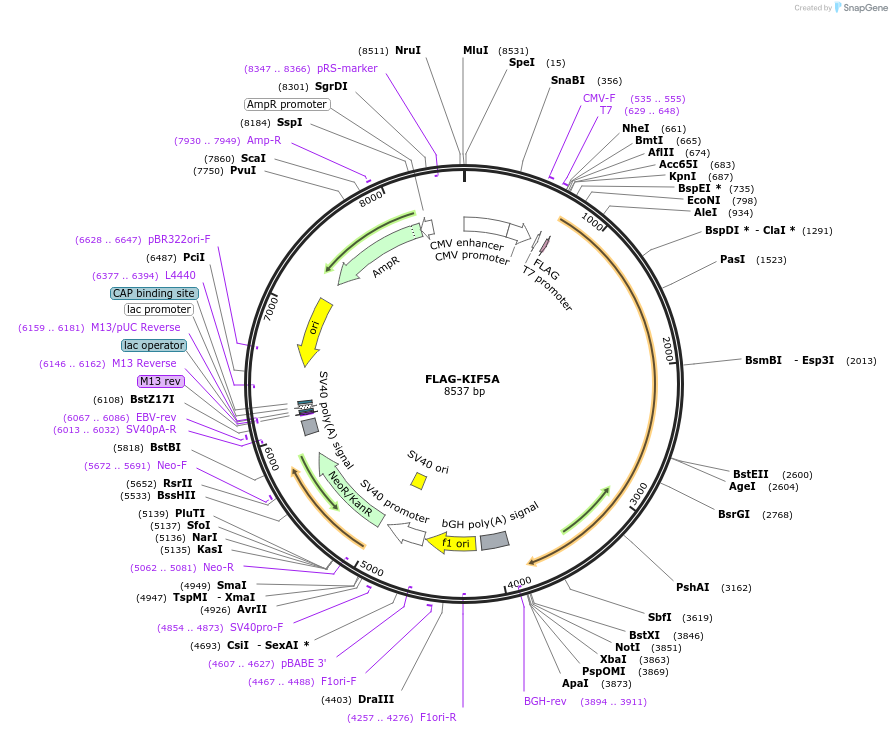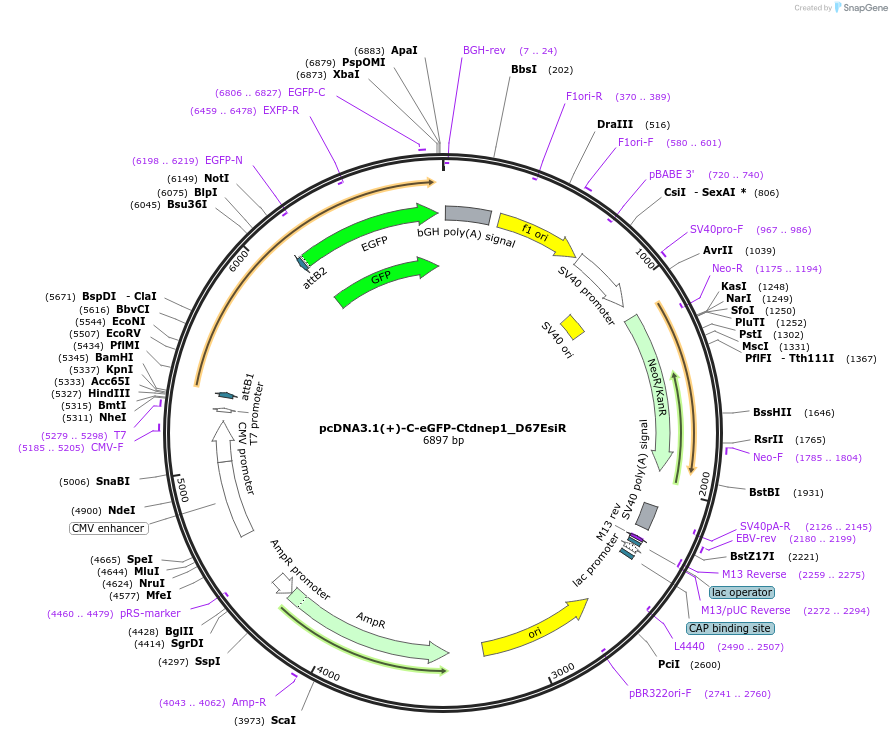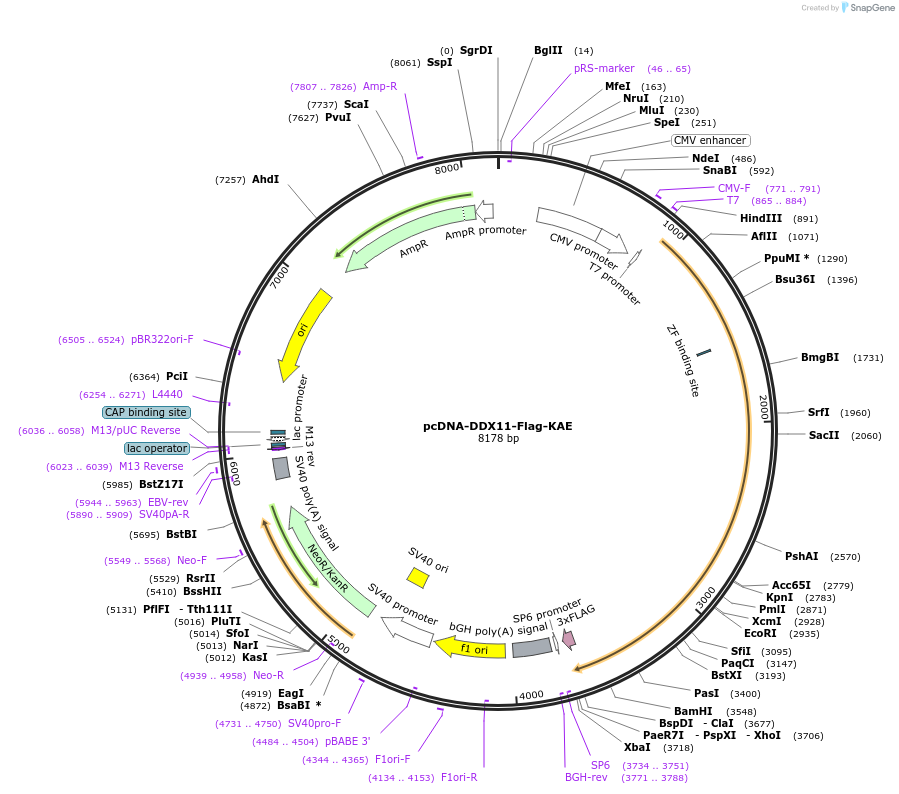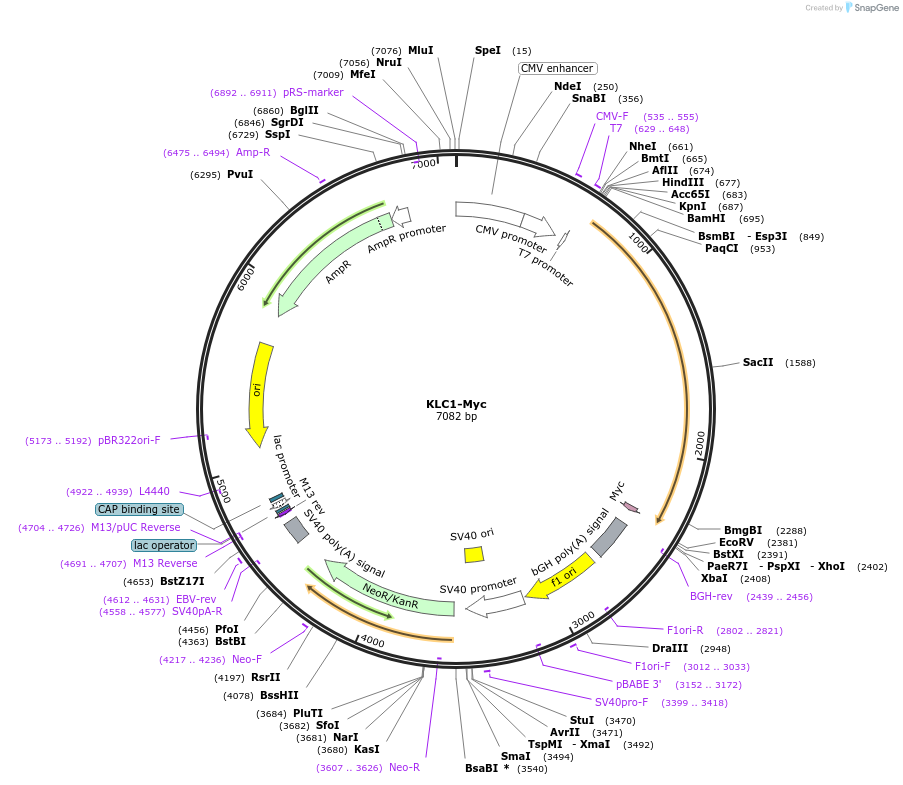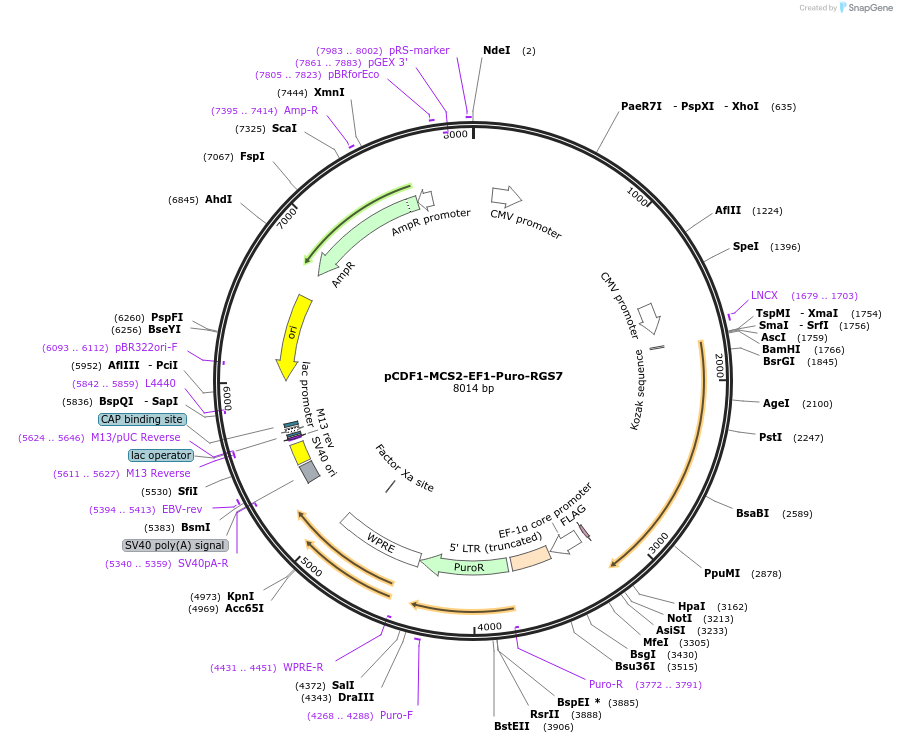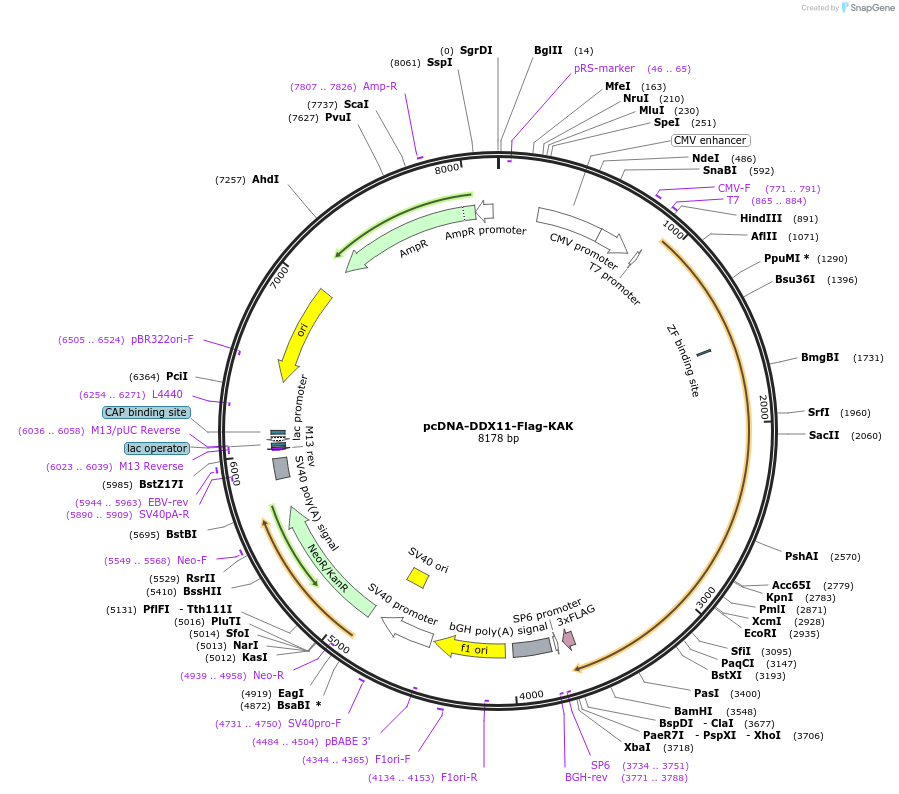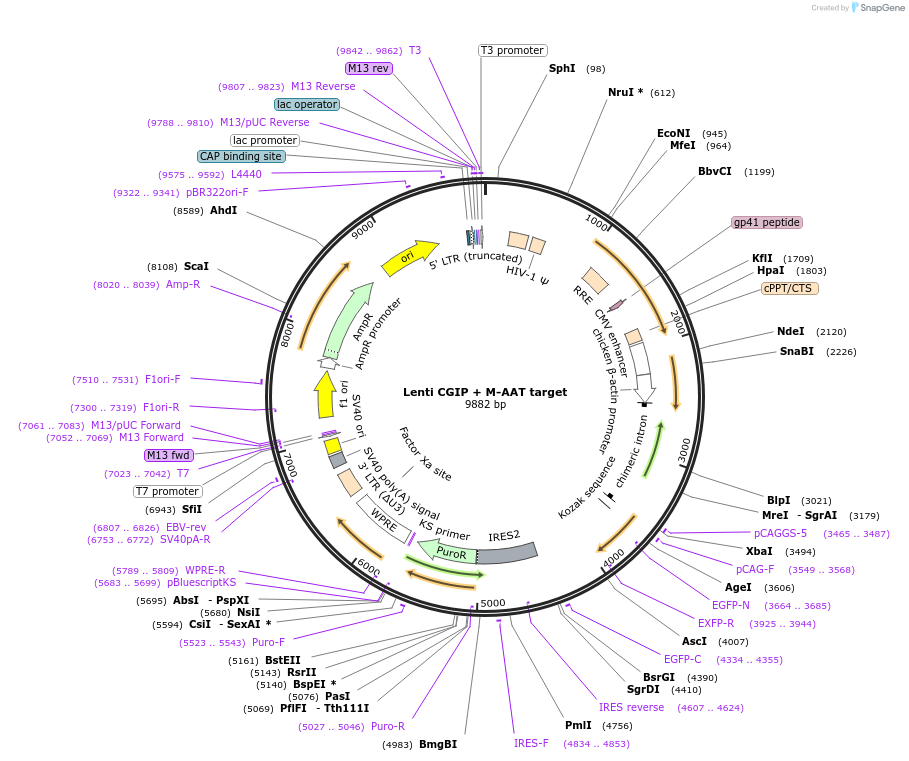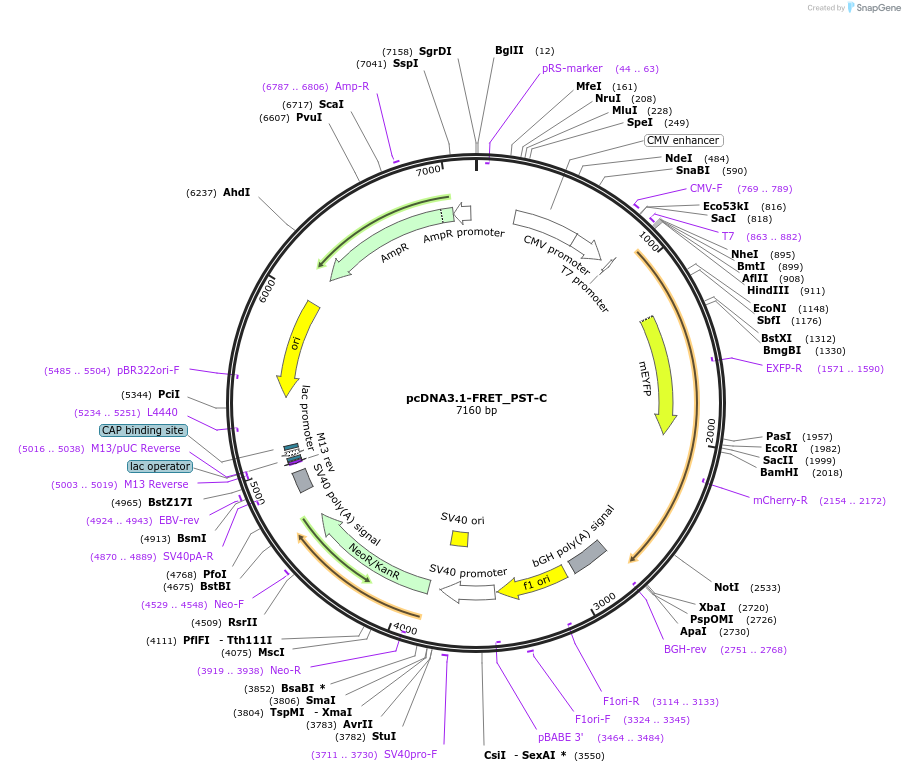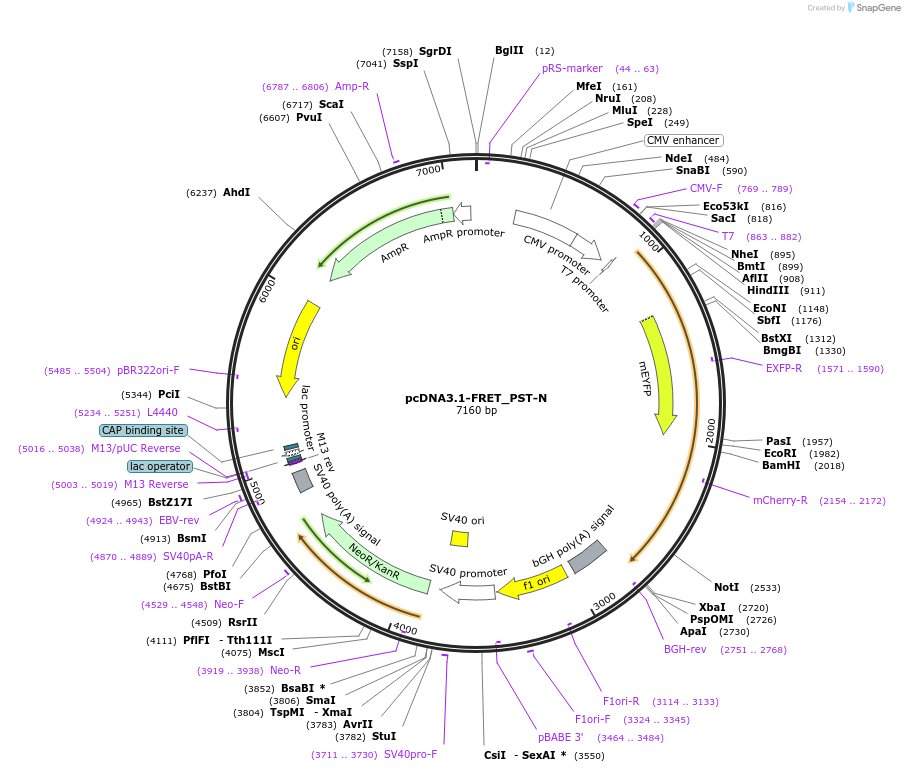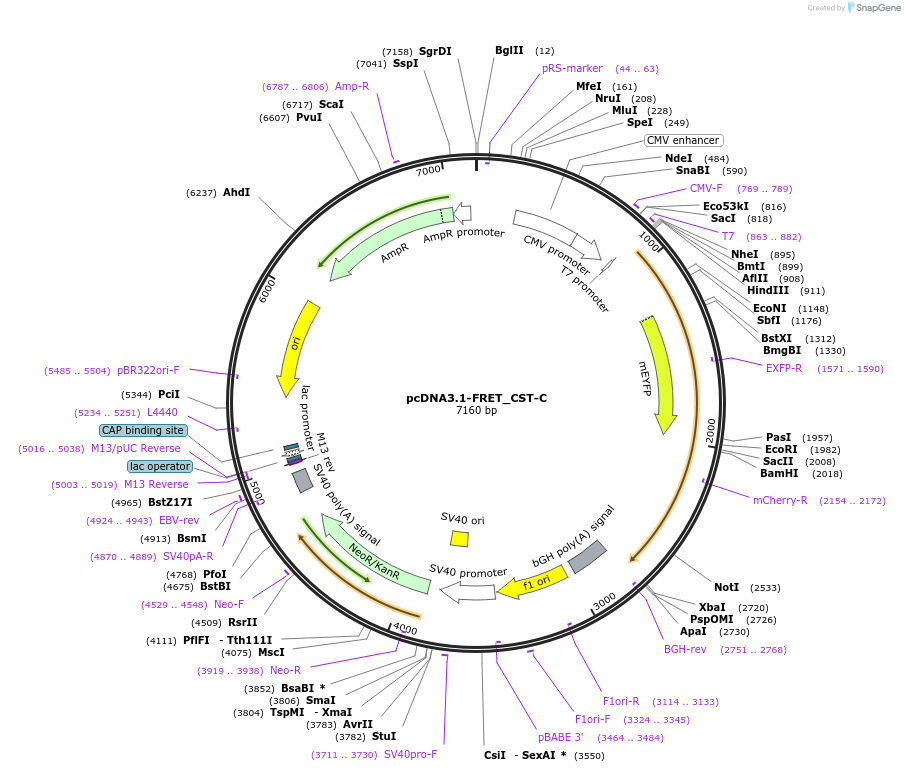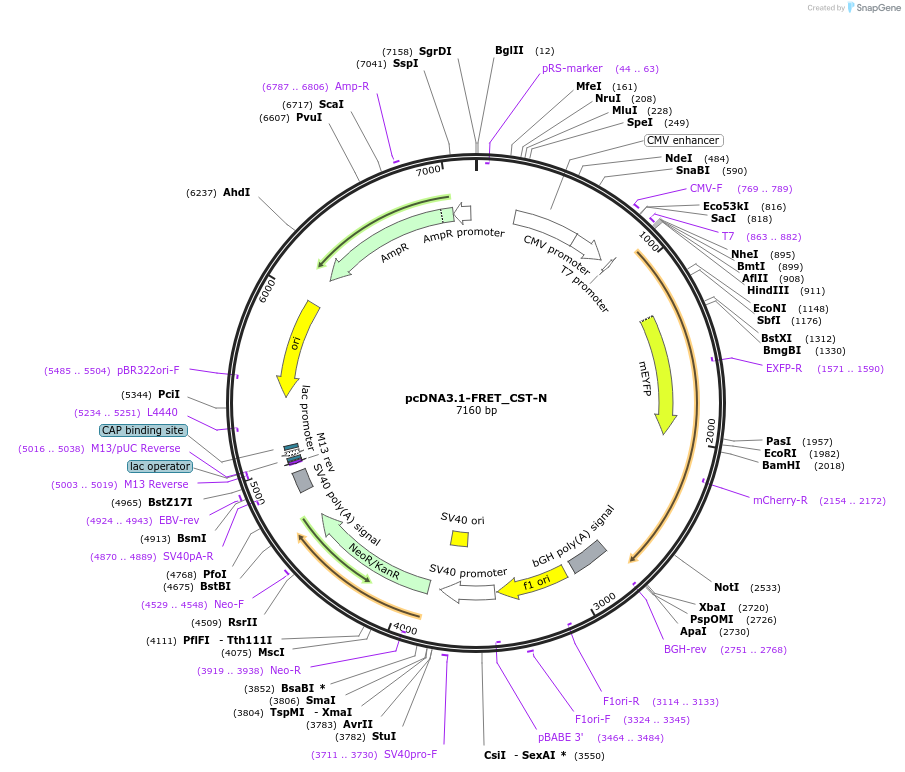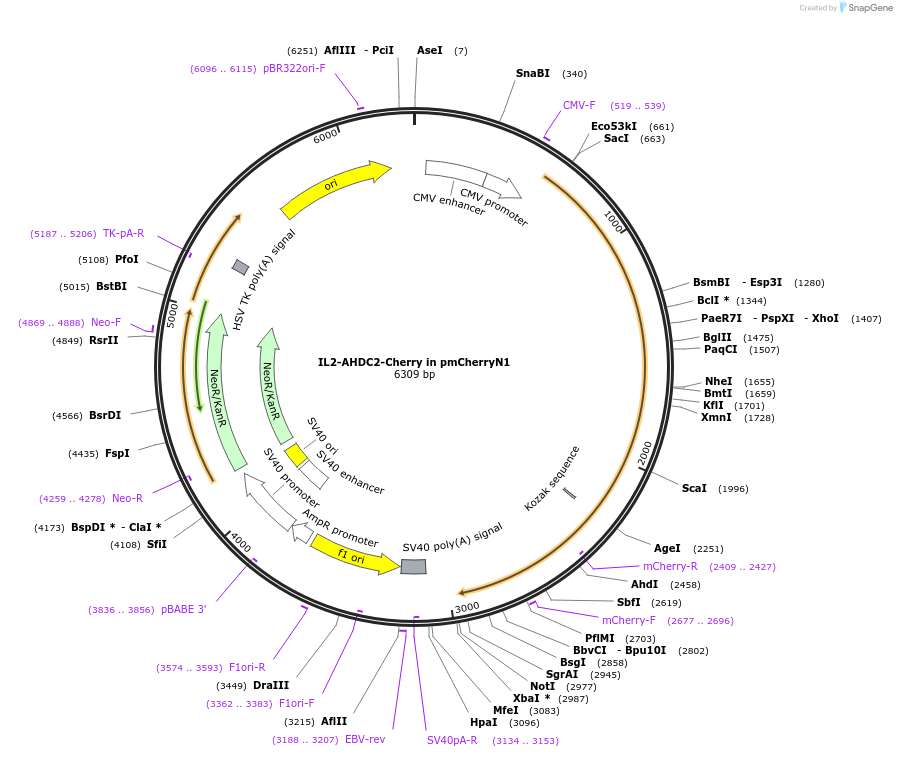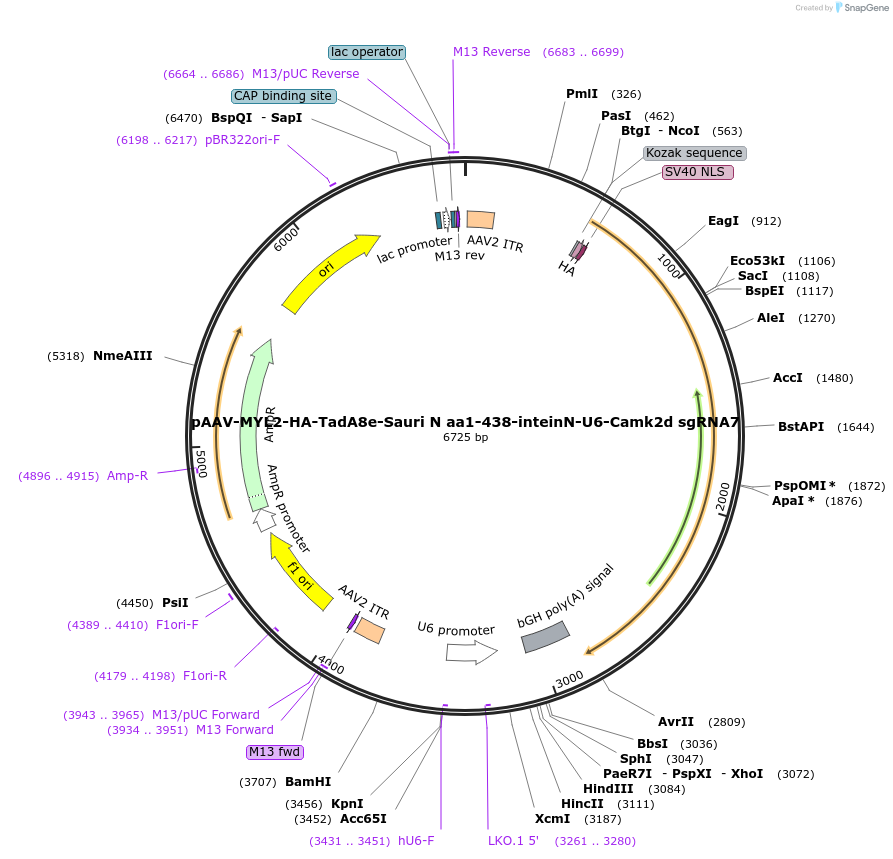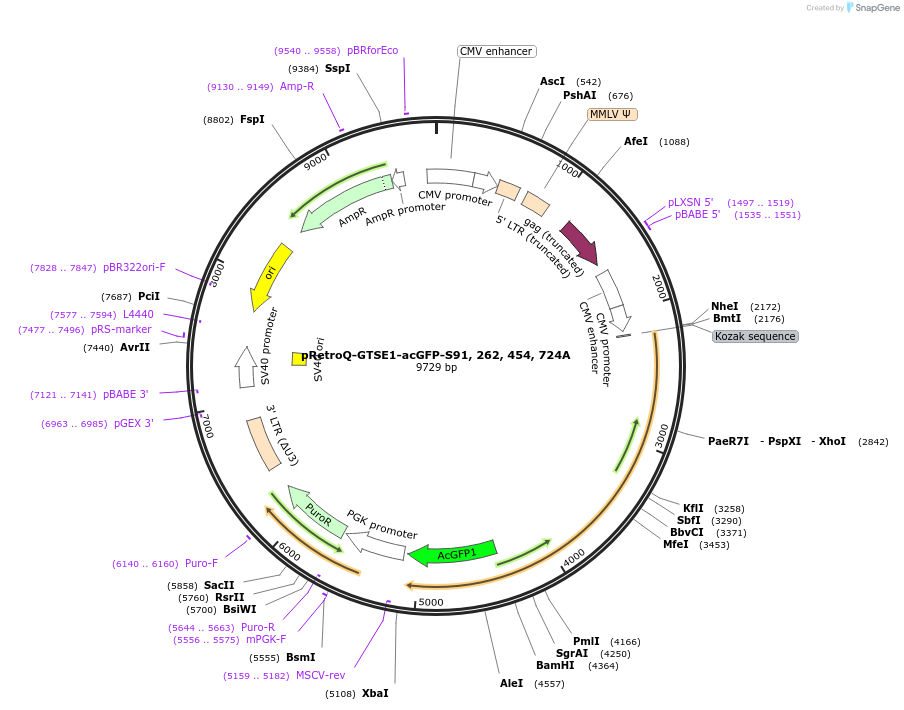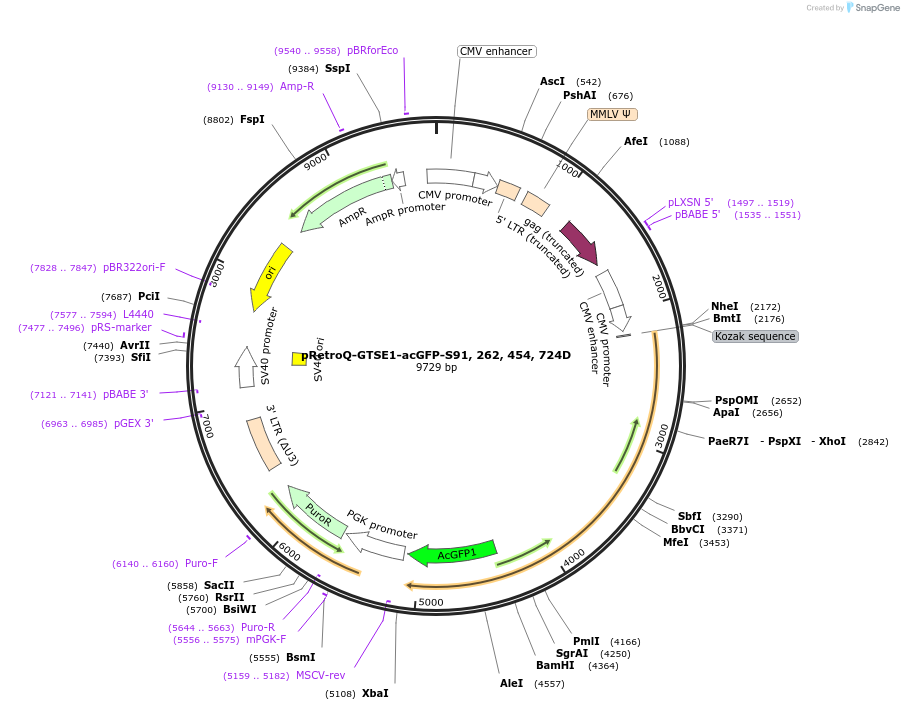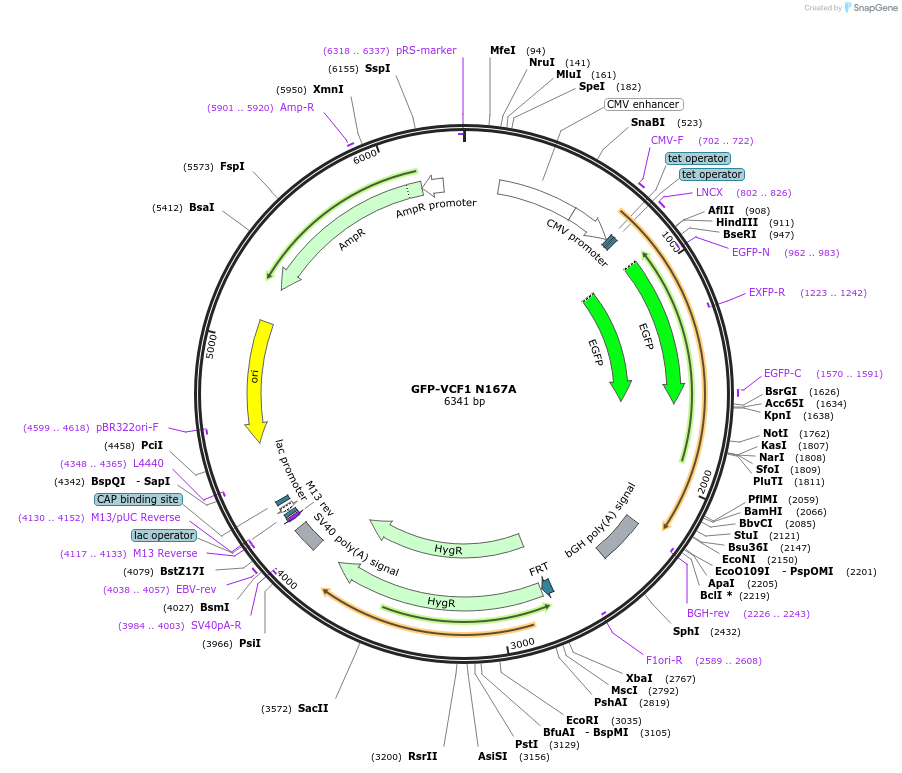We narrowed to 3,415 results for: cmv promoter
-
Plasmid#184630PurposeMammalian expression vector with N-terminal Flag for KBTBD4 R312RG expression in mammalian cellsDepositorInsertN-terminal 3xFlag tagged KBTBD4 R312RG (KBTBD4 Human)
ExpressionMammalianMutationR312RGPromoterCMVAvailable SinceJune 3, 2022AvailabilityAcademic Institutions and Nonprofits only -
HEpl017
Plasmid#179992PurposepCBh_NLS_TadA8e_dSiCas12i_NLS_pA_pCMV_mCherry_pU6_crRNA_BbsI: vector for encoding a human codon-optimized dSiCas12i-ABE8e driven by CBh promoter and tagmCherry driven by CMV promoterDepositorInsertTadA8e-dSiCas12i(D1049A)
ExpressionMammalianAvailable SinceApril 4, 2022AvailabilityAcademic Institutions and Nonprofits only -
GFP-PCAF (delta5-53a.a.)
Plasmid#65388PurposeGFP-tagged BRD protein, which can be used to be expressed in mammalian cells.DepositorInsertPCAF (KAT2B Human)
TagsEmGFP and V5ExpressionMammalianMutationlost 13-159bp of the ORFPromoterCMVAvailable SinceMay 8, 2015AvailabilityAcademic Institutions and Nonprofits only -
pEGFP-Sec22b-P33-shR
Plasmid#208359PurposeMammalian expression of fluorescent N-terminally tagged shRNA resistant Sec22b-P33 mutantDepositorInsertSec22b (Sec22b Rat)
TagsEGFPExpressionMammalianMutationfour silent mutations (shRNA resistance), 33 aa p…PromoterCMVAvailable SinceApril 16, 2024AvailabilityAcademic Institutions and Nonprofits only -
FLAG-KIF5A
Plasmid#166954PurposeExpresses FLAG-tagged KIF5A protein in pcDNA3.1DepositorAvailable SinceMarch 18, 2021AvailabilityAcademic Institutions and Nonprofits only -
Flag-KLF6-4D (1054)
Plasmid#49490Purposeexpresses human Flag tagged KLF6 with 4D mutationDepositorInsertKFL6-4D (KLF6 Human)
TagsFlagExpressionMammalianMutationthree serines and one tyrosine mutated to aspart…PromoterCMVAvailable SinceFeb. 18, 2014AvailabilityAcademic Institutions and Nonprofits only -
flag-hKLF6-4A (1010)
Plasmid#49489Purposeexpresses human Flag tagged KLF6 with 4A mutationDepositorInsertKFL6-4A (KLF6 Human)
TagsFlagExpressionMammalianMutationthree serines and one tyrosine mutated to alanin…PromoterCMVAvailable SinceFeb. 18, 2014AvailabilityAcademic Institutions and Nonprofits only -
pcDNA3.1(+)-C-eGFP-Ctdnep1_D67EsiR
Plasmid#196518PurposeExpression of Ctdnep1_D67E-GFPDepositorInsertCtdnep1_D67EsiR (CTDNEP1 Human)
TagseGFPExpressionMammalianMutationD67E mutation (phosphastase dead). Silent mutatio…PromoterCMV promoter; T7 promoterAvailable SinceMarch 6, 2023AvailabilityAcademic Institutions and Nonprofits only -
pEGFP-RNF138-delta 18-58
Plasmid#78921PurposeMammalian expression of RNF138 with delta 18-58 and an EGFP fusionDepositorAvailable SinceJune 27, 2016AvailabilityAcademic Institutions and Nonprofits only -
pcDNA-DDX11-Flag-KAE
Plasmid#120728PurposeExpression of a Flag-tagged version of DDX11 KAE mutant in mammalian cellsDepositorInsertDDX11 KAE mutant (DDX11 Human)
Tags3x FLAGExpressionMammalianMutationSubstitution of E201 and Y202 with K and APromoterCMVAvailable SinceFeb. 11, 2019AvailabilityAcademic Institutions and Nonprofits only -
KLC1-Myc
Plasmid#166962PurposeExpresses FLAG-tagged SFPQ Y527A protein in pcDNA3.1DepositorAvailable SinceMarch 18, 2021AvailabilityAcademic Institutions and Nonprofits only -
pCDF1-MCS2-EF1-Puro-RGS7
Plasmid#113728PurposeExpress RGS7 in mamalian cellsDepositorAvailable SinceSept. 12, 2018AvailabilityAcademic Institutions and Nonprofits only -
pcDNA-DDX11-Flag-KAK
Plasmid#120729PurposeExpression of a Flag-tagged version of DDX11 KAK mutant in mammalian cellsDepositorInsertDDX11 KAK mutant (DDX11 Human)
Tags3x FLAGExpressionMammalianMutationSubstitution of E201, Y202 and E203 with K, A and…PromoterCMVAvailable SinceFeb. 11, 2019AvailabilityAcademic Institutions and Nonprofits only -
pEGFP-RNF138-delta 86-105
Plasmid#78922PurposeMammalian expression of RNF138 with delta 86-105 and an EGFP fusionDepositorAvailable SinceJune 27, 2016AvailabilityAcademic Institutions and Nonprofits only -
pEGFP-RNF138-delta 158-180
Plasmid#78923PurposeMammalian expression of RNF138 with delta 158-180 and an EGFP fusionDepositorAvailable SinceJune 27, 2016AvailabilityAcademic Institutions and Nonprofits only -
pEGFP-RNF138-delta 189-215
Plasmid#78924PurposeMammalian expression of RNF138 with delta 189-215 and an EGFP fusionDepositorAvailable SinceJune 27, 2016AvailabilityAcademic Institutions and Nonprofits only -
pcDNA3.1 - HA-KLF4 FL delta K5S
Plasmid#34594DepositorInsertKLF4 (KLF4 Human)
TagsHA tagExpressionMammalianMutationdeletion of K5S, corresponding to bases 1781 to 2…PromoterCMVAvailable SinceJan. 24, 2012AvailabilityAcademic Institutions and Nonprofits only -
Lenti CGIP + M-AAT target
Plasmid#86008Purposelenti reporter plasmid with M-AAT-specific gRNA target-sequence, to be used with tGFP #26864DepositorInsertsCAG promoter
M-AAT target
UseLentiviralMutationV30MAvailable SinceFeb. 1, 2017AvailabilityAcademic Institutions and Nonprofits only -
pMIR-Report-Luc-KLF4-K5S-Mt344A
Plasmid#34601DepositorInsertKLF4 (KLF4 Human)
UseLuciferaseExpressionMammalianMutationThe KLF4 K5S region was mutated at the miR-344 bi…PromoterCMVAvailable SinceFeb. 2, 2012AvailabilityAcademic Institutions and Nonprofits only -
pMIR-Report-Luc-KLF4-K5S-Mt206B
Plasmid#34600DepositorInsertKLF4 (KLF4 Human)
UseLuciferaseExpressionMammalianMutationThe KLF4 K5S region was mutated at the miR-206 bi…PromoterCMVAvailable SinceFeb. 2, 2012AvailabilityAcademic Institutions and Nonprofits only -
pcDNA3.1-FRET_PST-C
Plasmid#228570PurposeExpressed a FRET sensor for determining proteolytic cleavage of the C-terminal side of PancreastatinDepositorInsertChromogranin-A (CHGA Human)
TagsmCitrine and mScarlet-IExpressionMammalianMutationFRET sensor; see explanatory notePromotercmvAvailable SinceJuly 1, 2025AvailabilityAcademic Institutions and Nonprofits only -
pcDNA3.1-FRET_PST-N
Plasmid#228571PurposeExpressed a FRET sensor for determining proteolytic cleavage of the N-terminal side of PancreastatinDepositorInsertChromogranin-A (CHGA Human)
TagsmCitrine and mScarlet-IExpressionMammalianMutationFRET sensor; see explanatory notePromotercmvAvailable SinceJuly 1, 2025AvailabilityAcademic Institutions and Nonprofits only -
pcDNA3.1-FRET_CST-C
Plasmid#228572PurposeExpressed a FRET sensor for determining proteolytic cleavage of the C-terminal side of CatestatinDepositorInsertChromogranin-A (CHGA Human)
TagsmCitrine and mScarlet-IExpressionMammalianMutationFRET sensor; see explanatory notePromotercmvAvailable SinceJuly 1, 2025AvailabilityAcademic Institutions and Nonprofits only -
pcDNA3.1-FRET_CST-N
Plasmid#228573PurposeExpressed a FRET sensor for determining proteolytic cleavage of the N-terminal side of CatestatinDepositorInsertChromogranin-A (CHGA Human)
TagsmCitrine and mScarlet-IExpressionMammalianMutationFRET sensor; see explanatory notePromotercmvAvailable SinceJuly 1, 2025AvailabilityAcademic Institutions and Nonprofits only -
IL2-AHDC2-Cherry in pmCherryN1
Plasmid#187291PurposeExpress pmCherry-IL2-AH-deltaC2DepositorTagsmCherryExpressionMammalianMutationAH-deltaC2PromoterCMVAvailable SinceFeb. 6, 2025AvailabilityAcademic Institutions and Nonprofits only -
pAAV-MYL2-HA-TadA8e-Sauri N aa1-438-inteinN-U6-Camk2d sgRNA7
Plasmid#226678PurposeExpresses TadA8e and Sauri cas9N by MYL2 promoter and sgRNA targeting murine Camk2d intron7 5' splice site by U6 promoterDepositorInsertMYL2, TadA, nSauri Cas9N, inteinN
UseAAVPromoterMYL2Available SinceJan. 16, 2025AvailabilityAcademic Institutions and Nonprofits only -
pRetroQ-GTSE1-acGFP-S91, 262, 454, 724A
Plasmid#224741PurposeRetroviral vector for delivery and expression of acGFP1-tagged GTSE1 protein with S91, 262, 454, 724A mutationDepositorInsertGTSE1 (GTSE1 Human)
UseRetroviralTagsacGFPMutationSerine 91, 262, 454, 724 to AlaninePromoterCMVAvailable SinceDec. 23, 2024AvailabilityAcademic Institutions and Nonprofits only -
pRetroQ-GTSE1-acGFP-S91, 262, 454, 724D
Plasmid#224742PurposeRetroviral vector for delivery and expression of acGFP1-tagged GTSE1 protein with S91, 262, 454, 724D mutationDepositorInsertGTSE1 (GTSE1 Human)
UseRetroviralTagsacGFPMutationSerine 91, 262, 454, 724 Aspartate; Valine 53 Iso…PromoterCMVAvailable SinceDec. 23, 2024AvailabilityAcademic Institutions and Nonprofits only -
GFP-VCF1 N167A
Plasmid#223019PurposeExpression of GFP-tagged VCF1 (p97 binding-deficient N167A mutant) in mammalian cells.DepositorAvailable SinceSept. 10, 2024AvailabilityAcademic Institutions and Nonprofits only -
Strep-HA-VCF1 N167A
Plasmid#223021PurposeExpression of Strep-HA-tagged VCF1 (p97 binding-deficient N167A mutant) in mammalian cells.DepositorAvailable SinceSept. 10, 2024AvailabilityAcademic Institutions and Nonprofits only





